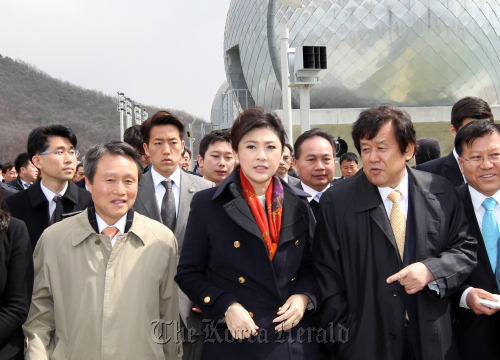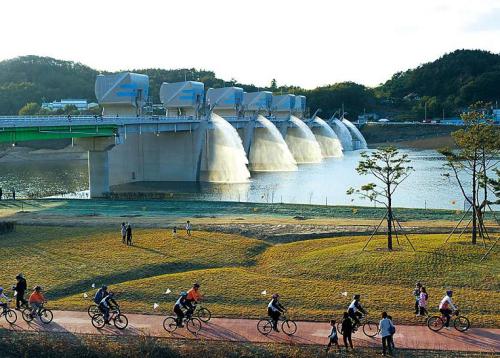“Even after the project is completed, we will be setting up extra wind power stations along the Geum, Yeongsan and Nakdong Rivers if it proves feasible.”
The project is also projected to save 1.25 billion tons of water by building small and medium-sized dams and developing reservoirs for agricultural use, the ministry noted, while improving water quality by stopping and purifying dirty water coming to rivers.
Participant builders include Samsung C&T, POSCO Engineering and Construction, Hyundai Engineering and Construction, GS Engineering and Construction and Daelim Industrial.
On the economic front, the ministry added that the program created some 190,000 new jobs in the construction sector, although critics say it ended up creating only 4,000.
Controversy
The government, however, has been struggling to decouple its mega river project from fierce criticism over environmental degradation since its introduction.
Some municipalities boycotted the work. Civic groups and environmentalists staged rallies in areas along the rivers, claiming that a substantial dredging of the riverbed to dig watercourses deeper made some areas even more vulnerable to flooding. A handful of scholars also warned the project endangers local wildlife and undermines ecosystem dynamics.
Opposition lawmakers tagged the project a “lavish political venture,” demanding that the construction of large-scale river barrages, dams and bike roads be called off.
In February, a Busan high court ruled that restoration work on the Nakdong River was unconstitutional, saying the task had not undergone a preliminary feasibility test required for any government program worth 50 billion won or more.
But the judge dismissed the case because “rescinding the whole process when it is near completion goes against the public good.” The Land Ministry said it has appealed to prove the project’s legitimacy.
“The river restoration work is almost the only program executed in earnest by Lee and his administration other than a tax break for the wealthy,” said Rhyu Si-min, co-leader of the minor opposition Unified Progressive Party, during a television debate in November.
“You should spend your budget on areas with large job creation effects especially if you expect a shortfall in tax revenues. But this government hasn’t even bothered to perform a cost-benefit analysis, let alone environmental impact assessments.”
Another blow came early this year when the state-run Korea Research Institute for Human Settlements calculated this year’s river maintenance costs at 612.5 billion won. The ministry called it an “overestimate,” arguing 163 billion would suffice.
The government added fuel to the flames by spending a massive amount of taxpayers’ money to promote the effects of the project and publicize residents’ positive reviews since late last year through media outlets and public events.
Shim at the ministry rebuffed such criticism. Residents who had resisted the project citing its environmental impact have been increasingly positive toward it as they see the waterways in better shape and once-frail streams survived torrential rains last summer without severe damage, he said.
“The project has often been misrepresented as a political ploy,” Shim said. “But this is not a political issue but a technical one, which requires technical discussions, not such ideological, political disputes.”
According to the ministry, Korea’s total flood damage during the rainy season fell to 94.5 billion won last year, despite unusually heavy rain in some parts of the country. That figure is about 9 percent of the amount needed in 1998 and 6 percent of the 2006 amount.
“It is fortunate that the government has been building four times as many anti-disaster facilities as the current ones under the program in preparation for a rainstorm that might come once in 200 years,” Lee said in August.
“Because of this project, many waterside areas can stave off recurrent flood damage.”
In efforts to address persisting concerns, the ministry is keeping close track of the habitats of endangered species and reinforcing protection measures, Shim added.
In October, the government hosted an event to celebrate the revitalization of the four major rivers.
About 10,000 residents and public officials attended the one-day festival in the Gyeonggi Province city of Yeoju on the South Han River, which entailed a celebratory concert, tours, exhibitions and sports events for locals, such as windsurfing, kayaking, canoeing and cycling.
“I am delighted to give the rivers back to the people, which will now bring back life and provide residents with pleasure and safety from natural disasters,” Lee said at the ceremony.
“These rivers are reborn not just to secure water resources and protect against floods but to revitalize every nook and corner of Korea.”
Tech exports
With the gigantic program reaching its closing stages, the government invited policymakers, public officials and water experts from across the globe to prove its efficacy in raising water security and flood prevention.
Morocco, Paraguay, Malaysia and Vietnam are considering adopting Korea’s scheme for their own projects as early as next year, ministry officials said.
King Mohammed VI of Morocco dispatched several envoys here to discuss collaboration. Liz Rosanna Cramer Campos, the Paraguayan Tourism Minister, also paid a visit to Seoul to look into the technology, they added.
According to Shim, other officials in Southeast Asia, Africa and some European countries have officially expressed their interest in adopting Korea’s strategy.
“Water security emerged as a global issue because climate change has likely prompted extreme weather conditions that come with droughts, floods and water shortages even in rich countries,” Shim said.
“We have held talks with Morocco and Paraguay to sign a memorandum of understanding for technical cooperation next year, which would help the countries raise safeguards against recurrent floods and boost tourism revenues.”
Thai’s interest
On Sunday, Thailand’s Prime Minister Yingluck Shinawatra took a tour to the South Han River basins and discussed collaboration in water management with Korean officials, the Land Ministry said. She came to Seoul to attend the Nuclear Security Summit on March 26-27.
Her visit coincides with her government’s plan to draw up viable measures to stave off the country’s chronic flood problems, which killed more than 600 people and devastated millions of homes last year.
“Prime Minister Yingluck Shinawatra showed interests in our flood management skills and asked many questions about the flood control system, the accuracy of the forecasting regime and how it works with dams in the river,” the ministry said in a statement.
Earlier in November, Thaksin Shinawatra, her older brother and the Southeast Asian country’s former premier, looked around the sites. Thai Foreign Minister Surapong Tovichakchaikul also visited Korea in October.
The high-profile visits could pave the way for Lee’s ambition for a technology export deal, Seoul officials say, valuing Thailand’s entire project at as much as 32 trillion won.
“The ministry and the Korea Water Resources Corp. have been in talks with the Thai government for ways to overhaul Thailand’s flood control system and share our experience and know-how,” a ministry official said.
By Shin Hyon-hee
(
heeshin@heraldcorp.com)









![[Today’s K-pop] Blackpink’s Jennie, Lisa invited to Coachella as solo acts](http://res.heraldm.com/phpwas/restmb_idxmake.php?idx=644&simg=/content/image/2024/11/21/20241121050099_0.jpg)